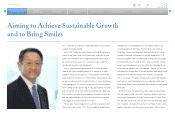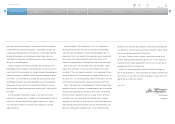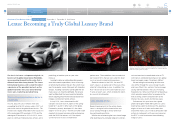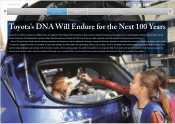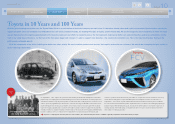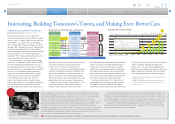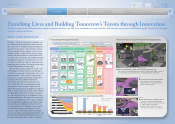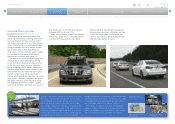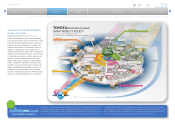Toyota 2014 Annual Report Download - page 13
Download and view the complete annual report
Please find page 13 of the 2014 Toyota annual report below. You can navigate through the pages in the report by either clicking on the pages listed below, or by using the keyword search tool below to find specific information within the annual report.
ANNUAL REPORT 2014
President’s MessagePresident’s Message
Overview of
Four Business Units
Overview of
Four Business Units
Special FeatureSpecial Feature
Review of OperationsReview of Operations
Consolidated Performance
Highlights
Consolidated Performance
Highlights
Management and
Corporate Information
Management and
Corporate Information
Investor InformationInvestor Information
Financial SectionFinancial Section
Page 13
NextPrev
ContentsSearchPrint
Building the right cars in
the right places
Over half a century has passed since Toyota
exported its first two Crowns to North America in
1957, and it has been almost 30 years since
Toyota started building cars in North America,
beginning with New United Motor Manufacturing,
Inc., in 1986.
Through the 1980s, Toyota was well known as
a maker of mid-sized and compact passenger
cars, such as the Camry and Corolla, as well as
the Hilux small pickup truck. In 1989, Toyota
launched the Lexus brand as its entry into the
luxury passenger car market. From that point
onward, it expanded its lineups of luxury vehicles
and cars for young drivers as well as light-duty
trucks, and introduced hybrid models, changing
its image as a carmaker and increasing its pres-
ence in the U.S. market.
Cumulative production volume in North
America reached 10 million vehicles in 2001, 20
million vehicles at the end of 2008, and 25 million
vehicles in October 2012. In May 2014, Toyota’s
Under his guidance, and based on intricate market
research, the Camry has evolved into a car with
bold form and solid handling.
plant in Kentucky, which started production in
May 1988, became the first Toyota plant outside
Japan to have produced 10 million vehicles.
Today, in the United States and Canada, Toyota
has 11* manufacturing companies, three distribu-
tors, and a network of more than 1,750 dealers
that sell more than two million Toyota and Lexus
vehicles annually.
In our quest to innovate and make tomorrow’s
Toyota even better than today’s, we have decided
to establish a new North American headquarters,
moving our regional manufacturing, sales and
marketing, corporate, and financial services head-
quarters to a single location in Plano, Texas. The
move is intended to increase efficiency and
collaboration throughout the organization, with
the ultimate aim of ensuring sustained growth in
North America by creating a business structure
that allows us to deliver ever-better cars to
customers.
Ahead of this strengthening of our business
foundation and in line with our principle of build-
ing the right cars in the right places, we have
assigned an American as the chief engineer over-
seeing the redesign of the flagship Camry model.
* Excluding Subaru of Indiana Automotive, Inc., which produces
vehicles on a commissioned basis
Cumulative production volume at Toyota Motor Manufacturing, Kentucky has reached 10 million vehicles.
In November 1966, the first-generation Corolla was launched in anticipation of the arrival of mass motori-
zation. The car’s sales gained momentum in 1966, with the start of production at the newly constructed
Takaoka Plant in Aichi Prefecture and exports to Australia. In 1968 exports to North America began to
expand. As a result, total automobile output at Toyota, which was around 480,000 vehicles in 1965, more
than doubled to roughly 1,100,000 vehicles by 1968, increasing in line with sales of the first-generation
Corolla. In 1970, four years after the Corolla’s launch, cumulative worldwide sales of the car surpassed one
million, and the concept of building the right cars in the right places led to rave reviews around the globe.
The Corolla became the world’s best-selling car, reaching in 22.65 million cumulative sales in 1997. In July
2013, global cumulative sales of the Corolla crossed the 40 million vehicle mark. One in every five cars sold
over the last 76 years has been a Corolla. Always staying ahead of the times and paying attention to the
needs of our customers and society, Toyota has worked relentlessly to improve the technologies and quality
of the Corolla. Today, the Corolla is marketed in more than 150 countries and regions around the world, and
it is manufactured in 15 locations around the world, including two in Japan.
This is in line with a sentiment Sakichi Toyoda expressed at the construction of an automatic loom plant in
1921 in Shanghai, China, namely, “open your door, and look outside,” an apt reminder that we should keep
our eye on the world and cultivate the courage to take on any challenge.
The Corolla, adored by so many drivers around the world, is one car that laid the cornerstone for making ever-better cars.
The Corolla
Toyota’s
DNA
Toyota in 10 Years and 100 Years [4 of 6] Our DNA is Creating Ever-Better Cars What Sets Toyota Apart Enriching Lives and Building Tomorrow’s Toyota through Innovation New Values for the Next Hundred Years Message from the Executive Vice President Responsible for Accounting


